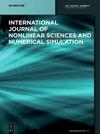Numerical simulation of particulate matter propagation in an indoor environment with various types of heating
IF 1.5
4区 工程技术
Q2 ENGINEERING, MULTIDISCIPLINARY
International Journal of Nonlinear Sciences and Numerical Simulation
Pub Date : 2022-05-11
DOI:10.1515/ijnsns-2021-0104
引用次数: 0
Abstract
Abstract The aim of the work is to describe the air flow in an enclosed space, which is ventilated by a diffuser, to select an appropriate turbulence model, to solve the problem using the ANSYS Fluent, to study the effect of heat sources in a room on air flow under various conditions and to simulate the movement of particulate matter. As a result, the distribution of PM2.5 particles in the room was shown, which enter the room through the diffuser. According to the data obtained, the temperature value increases with an increase in the area of the heat source, that is, with an increase in the number of batteries. The maximum temperature corresponds to a room with a warm floor, the minimum temperature is observed in a room with one battery. The obtained numerical data can be used when installing ventilation or heating devices inside buildings, when simulating the movement of harmful particles in the air, when determining the optimal ways to clean the air.不同加热方式下室内环境中颗粒物传播的数值模拟
摘要本文的目的是描述由扩散器通风的封闭空间中的气流,选择合适的湍流模型,使用ANSYS Fluent解决该问题,研究不同条件下房间内热源对气流的影响,并模拟颗粒物的运动。结果显示了PM2.5颗粒在房间中的分布,它们通过扩散器进入房间。根据获得的数据,温度值随着热源面积的增加而增加,也就是说,随着电池数量的增加而增大。最高温度对应于地板温暖的房间,最低温度在有一个电池的房间中观察到。所获得的数值数据可用于在建筑物内安装通风或供暖设备,模拟空气中有害颗粒的运动,确定清洁空气的最佳方式。
本文章由计算机程序翻译,如有差异,请以英文原文为准。
求助全文
约1分钟内获得全文
求助全文
来源期刊
CiteScore
2.80
自引率
6.70%
发文量
117
审稿时长
13.7 months
期刊介绍:
The International Journal of Nonlinear Sciences and Numerical Simulation publishes original papers on all subjects relevant to nonlinear sciences and numerical simulation. The journal is directed at Researchers in Nonlinear Sciences, Engineers, and Computational Scientists, Economists, and others, who either study the nature of nonlinear problems or conduct numerical simulations of nonlinear problems.

 求助内容:
求助内容: 应助结果提醒方式:
应助结果提醒方式:


